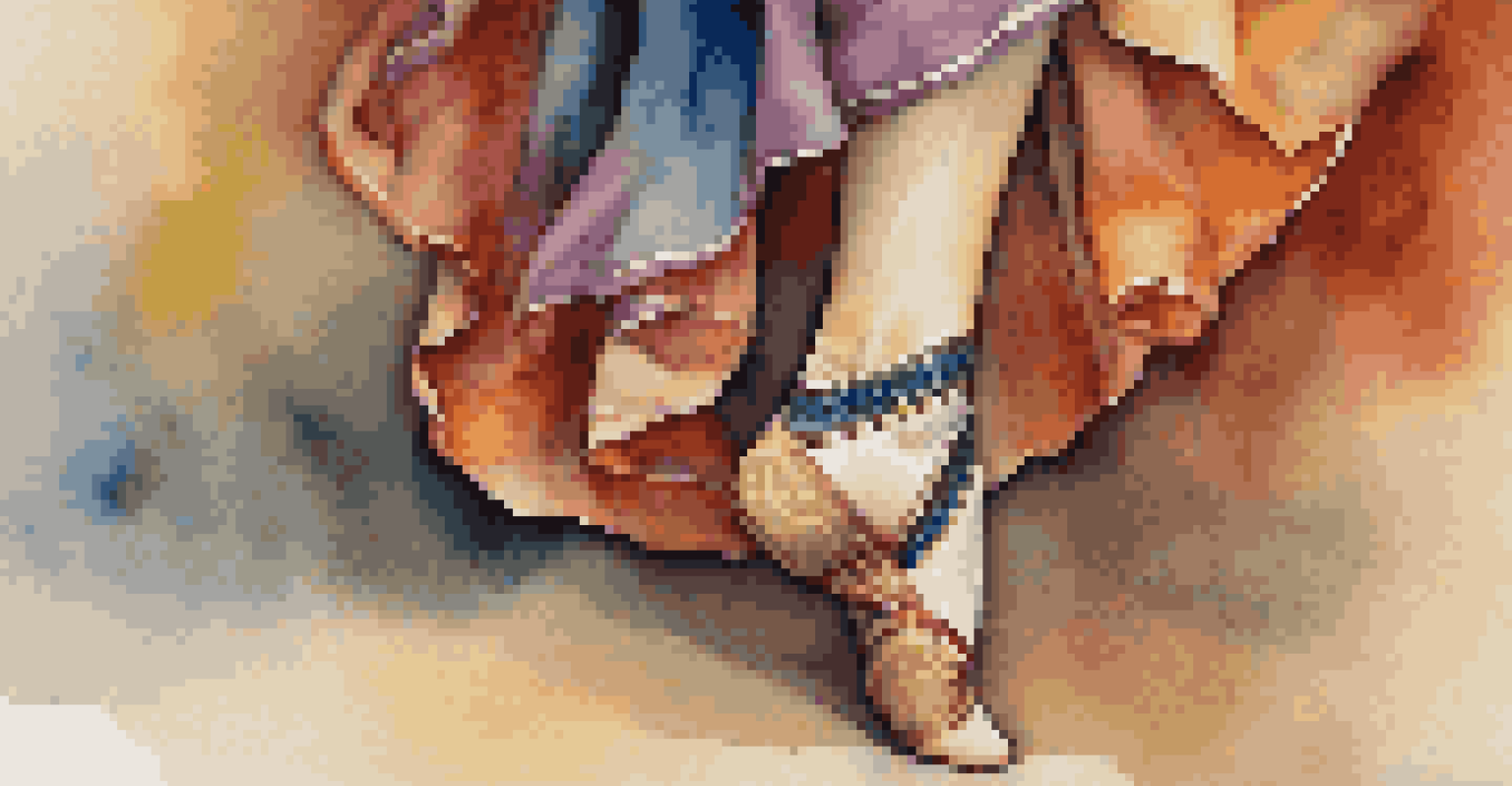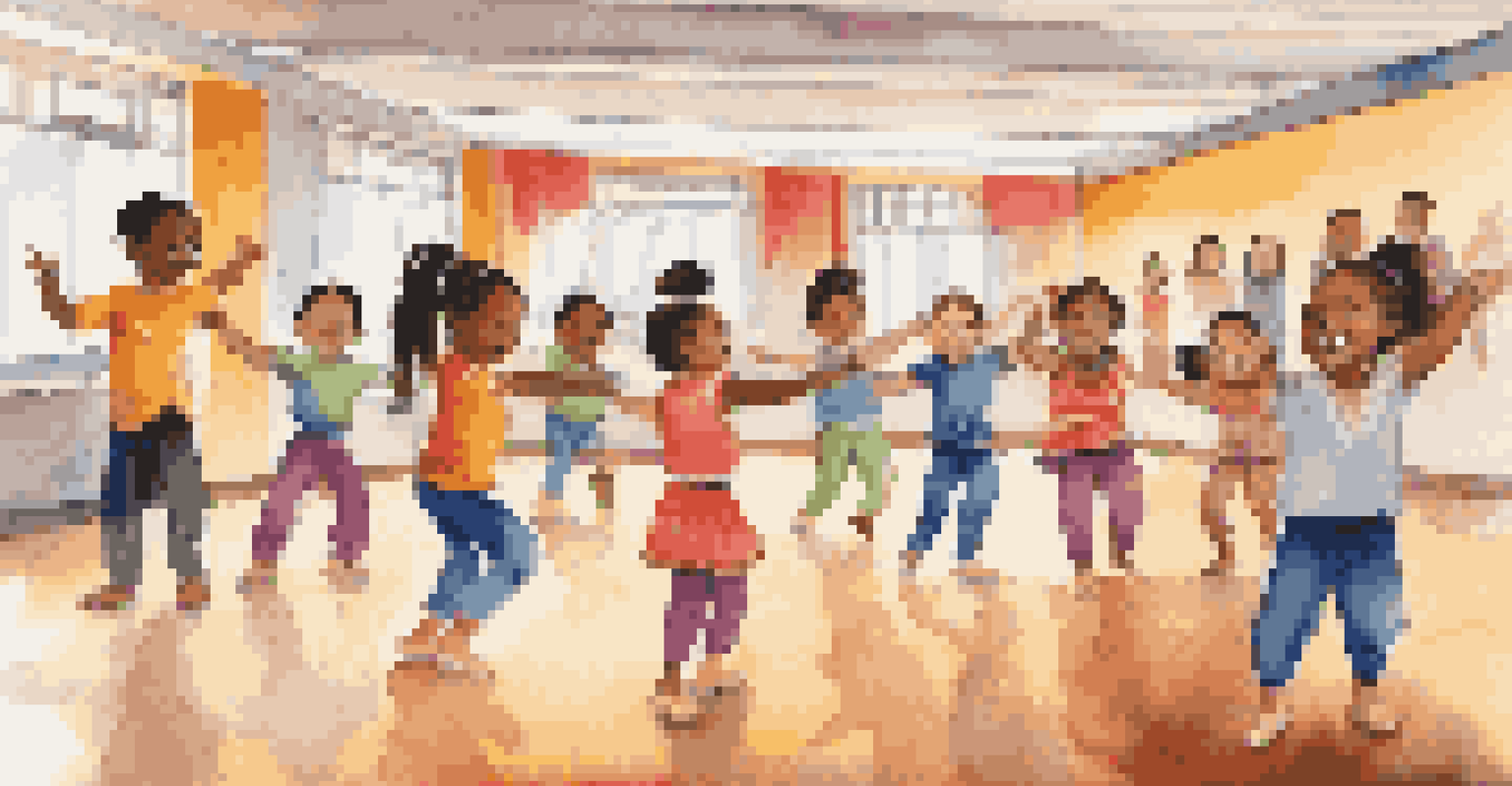Dance and Migration: Stories of Social Change through Movement

The Cultural Tapestry of Dance and Migration
Dance is more than just an art form; it's a vibrant expression of culture. As people migrate, they bring their unique dance styles, which blend with local traditions, creating new forms of expression. This cultural exchange enriches communities and fosters understanding, allowing different backgrounds to come together through movement.
Dance is the hidden language of the soul.
For instance, the fusion of African dance with Latin rhythms has led to the birth of genres like salsa and samba. These dances are not only a celebration of heritage but also a testament to how migration has shaped them. Each step and beat tells a story of struggle, resilience, and joy, highlighting the importance of cultural continuity in the face of change.
Through this cultural tapestry, we see that dance acts as a bridge connecting diverse communities. It enables individuals to share their stories, forging bonds that transcend language barriers. In essence, dance becomes a universal language of expression in the migration narrative.
Dance as a Tool for Social Integration
When migrants settle in new countries, dance plays a crucial role in social integration. Participating in local dance scenes helps newcomers build connections, fostering a sense of belonging. These interactions often lead to friendships that help break down cultural barriers, making it easier for migrants to navigate their new environments.

Community dance classes and performances provide a platform for sharing cultural heritage while also embracing local customs. For example, a traditional Middle Eastern dance group might collaborate with a local hip-hop crew, resulting in a unique performance that highlights both traditions. This not only nurtures mutual respect but also showcases the beauty of cultural exchange.
Dance Fosters Cultural Exchange
As people migrate, their unique dance styles blend with local traditions, creating new forms of expression that enrich communities.
Moreover, dance can empower marginalized communities, giving them a voice in the larger social landscape. Through public performances and community events, dancers can raise awareness about social issues, advocating for change while celebrating their identities. In this way, dance becomes a powerful medium for social integration and activism.
Traditional Dance Forms and Their Evolution
Traditional dance forms often evolve in response to the migratory patterns of people. As communities relocate, their dance styles adapt to new influences, creating a dynamic interplay between old and new. This evolution reflects the ongoing dialogue between tradition and innovation, showcasing how culture is never static.
The dance is a poem of which each movement is a word.
For instance, the Indian classical dance form Bharatanatyam has seen adaptations outside of India, integrating contemporary themes and modern music. This not only expands the reach of the dance but also allows for a reimagining of its narrative. Such adaptations keep traditions alive, breathing new life into age-old practices.
Ultimately, this evolution demonstrates the resilience of cultural expressions in the face of change. It highlights how dance can serve as a living history, capturing the essence of a community's journey while adapting to its current realities. Through these transformations, dance remains a vital part of cultural identity for migrants.
Dance and Identity in the Age of Migration
Migration often prompts individuals to reevaluate their identity, and dance plays an integral role in this process. For many, engaging in traditional dance can be a way to reconnect with their roots, providing a sense of stability amidst change. This reconnection fosters pride in their heritage, reinforcing their cultural identity.
Conversely, as migrants immerse themselves in the dance of their new communities, they may adopt new aspects of identity. This blending of cultures can lead to the creation of new dance styles that reflect a hybrid identity, illustrating the fluid nature of cultural belonging. It’s this interplay that makes dance a powerful tool for personal expression.
Dance Aids Social Integration
Participating in local dance scenes helps migrants build connections and navigate new environments, fostering a sense of belonging.
As a result, dance becomes a means of navigating the complexities of identity in a globalized world. It allows individuals to honor their past while also embracing their present, creating a unique narrative that celebrates both heritage and adaptation. This duality is essential in understanding the migrant experience through movement.
Dance as a Means of Advocacy and Activism
In recent years, dance has emerged as a powerful form of advocacy for social change, particularly among migrant communities. Dancers use their art to address pressing issues such as displacement, discrimination, and cultural preservation. Through performances, they can raise awareness and provoke thought about the challenges faced by migrants.
For example, the 'Dancing with Refugees' initiative uses dance workshops to empower displaced individuals, allowing them to express their stories through movement. This not only cultivates a sense of community but also provides a platform for dialogue around refugee rights and integration. Such initiatives highlight the potential of dance as a transformative tool for social justice.
Moreover, dance can serve as a form of protest, demanding recognition and change. Public performances in spaces like city squares or cultural festivals can attract attention and spark conversations about migrant experiences. By harnessing the power of movement, dancers become advocates for their communities, using their art to inspire action and change.
The Global Influence of Dance in Migration Narratives
Dance transcends geographical boundaries, influencing migration narratives around the world. As migrants settle in new places, they bring their dance styles with them, enriching the local cultural landscape. This global exchange creates a mosaic of movement, where different traditions blend and evolve, reflecting the interconnectedness of our societies.
Consider the global phenomenon of dance challenges on social media, which often originate from specific cultures and spread worldwide. These challenges, while entertaining, also serve to educate audiences about diverse cultural practices. They create a shared space for appreciation and understanding, showcasing the power of dance in unifying people across borders.
Dance Reflects Evolving Identities
Engagement in both traditional and local dance allows migrants to honor their heritage while embracing new cultural aspects.
Through this lens, we can see that dance is a vital part of the migration narrative. It encapsulates the stories of individuals and communities, highlighting their journeys and the cultural legacies they carry. Dance not only connects people but also amplifies the voices of those who have migrated, making their experiences part of a larger global conversation.
The Future of Dance in the Context of Migration
As we look to the future, the role of dance in migration narratives will likely continue to evolve. With advancements in technology, including virtual reality and online platforms, the way we experience and share dance is changing. This new landscape offers unprecedented opportunities for cultural exchange, allowing migrants to showcase their dance in innovative ways.
Moreover, as communities become more diverse, we can expect to see even greater fusion of dance styles. This blending of traditions will not only enrich the art form but also foster deeper connections among different cultural groups. The future of dance in the context of migration promises to be an exciting journey of collaboration and creativity.

Ultimately, dance will remain a powerful medium for expression, advocacy, and connection. It holds the potential to bridge gaps, celebrate diversity, and inspire social change, ensuring that every movement tells a story worth sharing. As we embrace the future, let's celebrate the transformative power of dance in shaping our world.